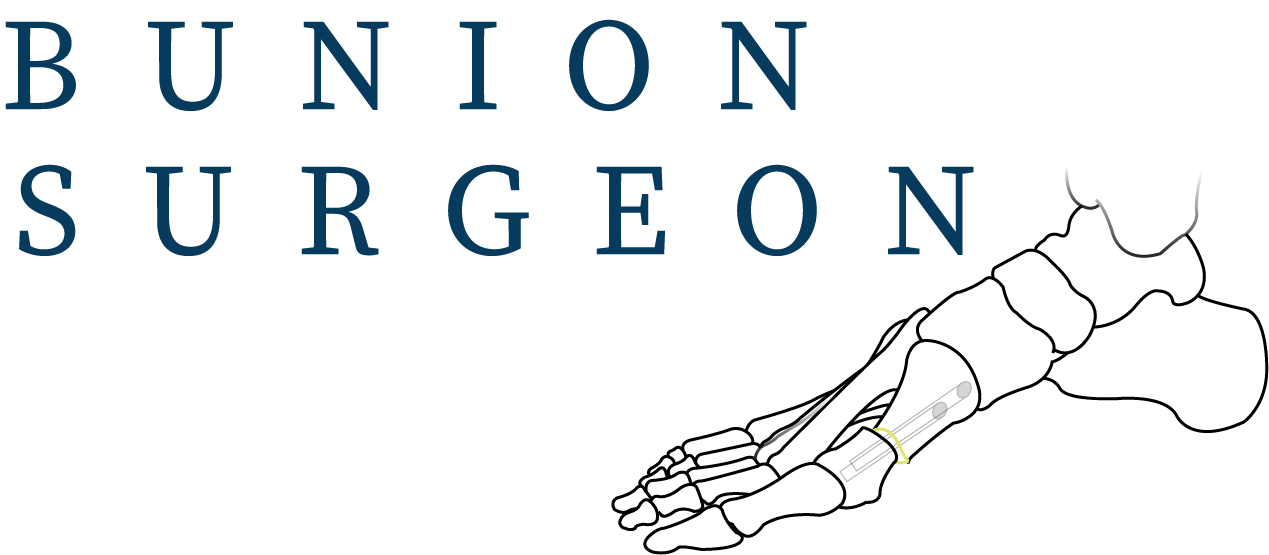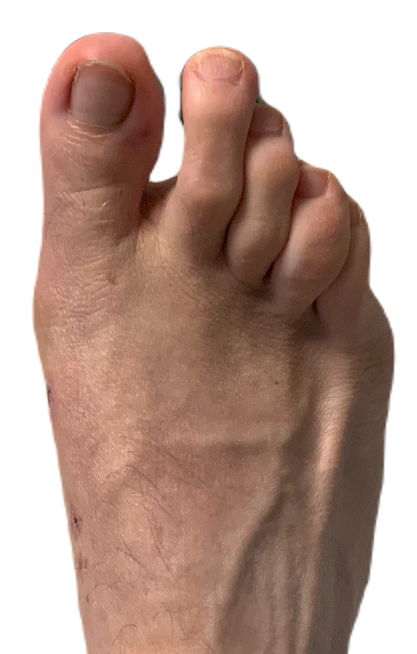

Step by step recovery following Bunion Surgery
Date published: 2024-01-10
A common question that we are asked at Bunion Surgeon is the recovery process following minimally invasive keyhole bunion surgery. This could involve additional question such as:
When will I be able to walk following bunion surgery?
When can I start to run following bunion surgery?
Expected level of pain following bunion surgery?
In this article we will outline the step by step recovery process for minimally invasive bunion surgery. One of our patient’s has happily consented to provide pictures of their postoperative. We hope this will help provide the necessary information for our future patients.
Pre-operative bunion surgery image

Eight weeks following bunion surgery

Day of surgery
Minimally invasive keyhole bunion surgery is typically arranged as a day case surgery under local anaesthesia or sedation, your surgeon will discuss the anaesthesia options with you during your consultation.
Once the bunion is corrected the foot will be bandaged, you will initially have a bulky bandage to protect the wound. A postoperative shoe and crutches will be provided, the physiotherapist will guide you through how to mobilise using these aids.
The first week following surgery
Over the first week you will experience the worst of the pain, you’ll be provided with painkillers to help manage this. You should rest for the first two-four days with your leg elevated.
You will immediately be able to walk for 10 minutes an hour, though it is important to elevate as much as possible to promote healing.
One week following surgery
Mr Kaser Nazir will review you either in person or over the phone to check your progress.
You should be able to mobilise for 15 minutes an hour, still with the use of a postoperative shoe. The swelling will have slightly subsided.
One week following bunion surgery

Two weeks following surgery
There will be a further review at two weeks in person, Mr Nazir will check your progress and remove the sutures. You will see that the swelling has subsided further, if this is sufficient, you will be able to move over to trainers.
You can now mobilise for 20 minutes an hour.
Two weeks following bunion surgery

Four to six weeks following surgery
You can now walk up to 30 minutes an hour and use static weights or an exercise bike.
Four weeks following bunion surgery

Six weeks following surgery
At this stage the swelling would have mostly subsided, you’ll be able to return to normal activities, including high impact. X-rays will be requested so Mr Nazir can check the fixation and the alignment of the bone.
Eight weeks following Bunion surgery

Issues to look out for following bunion surgery
As with any surgery, there are issues that can occur during the recovery process. Though Mr Nazir has a success rate of 95-97%, we have outlined possible signs of issues that you should be aware of following bunion surgery:
Increased pain: During the first few days following surgery you will experience some pain. If you notice a sudden increase in pain, or pain that does not improve with your provided pain medication, then this may indicate a problem. Contact Mr Nazir to discuss, he may suggest an X-ray to assess or provide advice on pain management.
Swelling and Redness: If there is persistent or worsening swelling and redness around the surgical site this may be indicative of an infection, or possible other issue.
Fever: If you have a temperature over 38°C contact Mr Nazir, a fever can indicate an infection
Abnormal discharge: Unusual or foul-smelling discharge from the incision site may indicate an infection.
Delayed healing: Contact Mr Nazir if the wound is not closing or shows signs of dehiscence (splitting open), where the surgical incision is delayed healing.
Numbness or tingling: Persistent numbness or tingling in the toes could be a sign of nerve damage.
Stiffness or limited range of motion: Persistent stiffness or difficulty moving the toe could indicate an issue with the surgical outcome. Mr Nazir may suggest an X-ray in this instance to assess the joint.
Non-healing ulcers or wounds: If the wound is not healing or you notice an ulcer this could be a sign of a complication, this is particularly an issue for individuals with diabetes.
Leg pain and enlarged veins: Pain in the legs and enlarged veins can be a sign of DVT (deep vein thrombosis). Following surgery you will be provided with compression stockings to help prevent the risk of DVT. It’s important to contact Mr Nazir as soon as possible should you notice these symptoms.
Fixation issue: Small screws are used during the bunion surgery to hold the toe in place. The body can reject these screws or they may move placement, there is a 2% risk of a fixation issue. Contact Mr Nazir who may request an X-ray to assess.
Visit our minimally invasive keyhole bunion surgery page to find out further information on the procedure and common questions asked.
Our administrative team and Mr Nazir are here to answer any questions and help you through your preoperative, intraoperative and postoperative process. Contact us today for further information or book an appointment online.